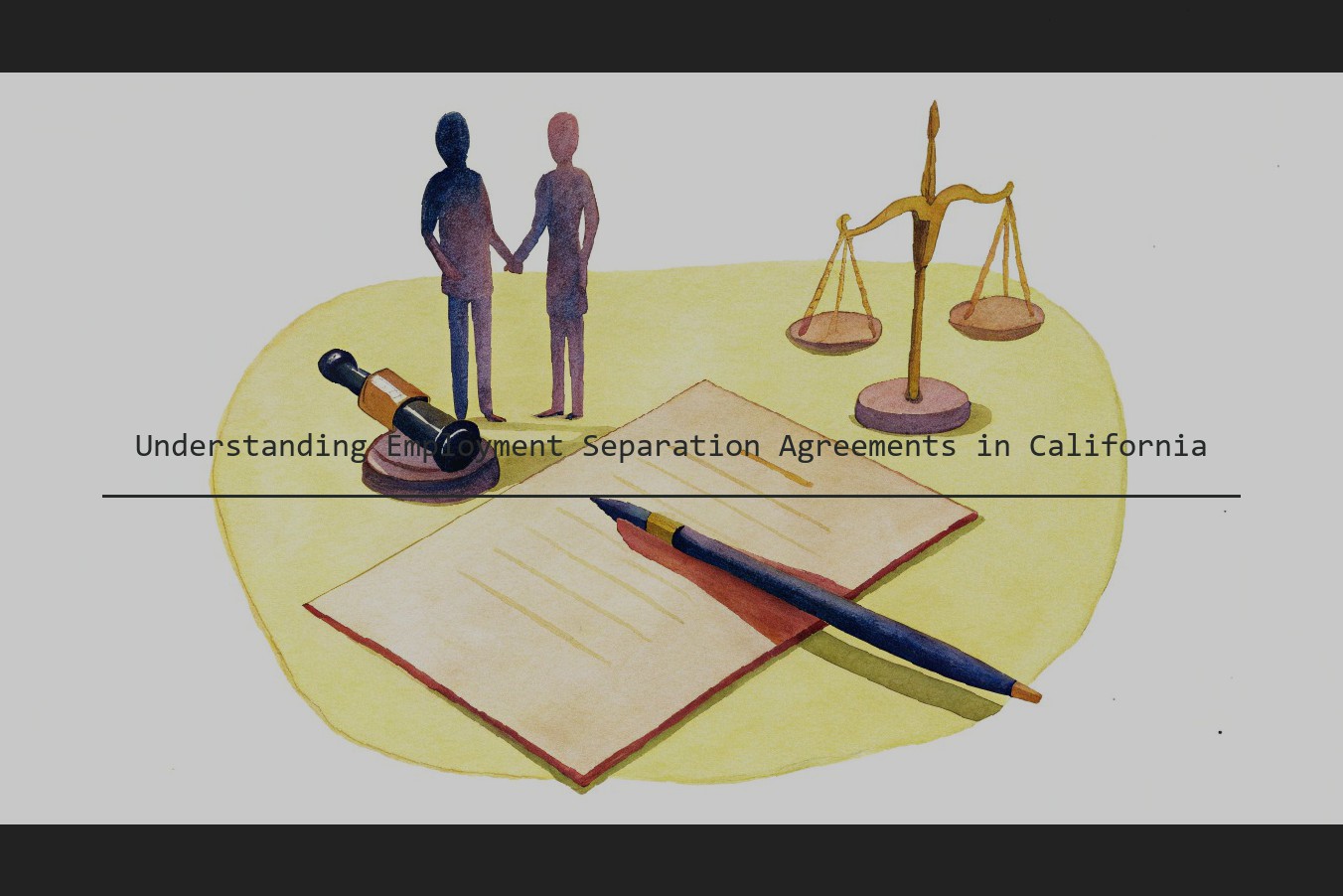What is an Employment Separation Agreement?
An employment separation agreement is a contract between an employer and an employee whereby the employee typically agrees to waive certain legal rights in exchange for money or certain benefits passed on by the employer. While there is no requirement that the employer provide anything over and above the employee’s normal pay or benefits, many employers offer separation pay or other benefits in exchange for the employee’s waiver of claims.
These agreements are relevant anytime an employment relationship is terminated. They are used most often in the context of a layoff of multiple employees whereby an employer may seek a release from each of the affected employees in exchange for a severance package. However , they no longer require mutual acceptance of the Agreement terms and thus today can be used as a tool to resolve individual disputes between employers and employees. They are also often used under circumstances where the employee’s employment is not ending but where certain business restructuring makes it helpful for plaintiff’s counsel to have a release of claims even if the plaintiff is not technically separating from the company.

Essential Elements of a California Separation Agreement
The key component of a California separation agreement is that it must be in writing and signed by the employee. On top of that, California law requires certain elements of the agreement to be either stated or incorporated into a written document presented to the employee at the time of discharge. Common elements include a confidentiality clause preventing the employee from publicizing the terms of their termination, a severance package or amount of pay for "overtime" work, a non-compete clause, and, on occasion, a non-solicitation clause preventing the employee from recruiting other employees away from the company. If there is a non-compete clause, attorneys should be involved to make sure the agreement complies with California law and the California Labor Code.
Legal Considerations and Protections
The key California statutory provisions include:
(a) California Labor Code Section 970 : No employer shall require any employee as a condition of employment or continued employment, or as a condition of receiving any employment benefit, to agree to either of the following:
(1) that any claim for wages (as defined in Section 215) arising out of or related to work or service performed in California shall be adjudicated in any county outside California.
(2) that any claim arising out of or related to any violation of law shall be adjudicated in a forum outside California. "Claim" does not include claims for workers’ compensation benefits or claims subject to the jurisdiction of the National Labor Relations Board.
(b) California Labor Code Sections 2695.7 – 2695.9 and 2699 (Regulation 17200). The regulations set forth requirements for employers regarding pay statements. (See section on pay statement requirements under the Fair Pay Act.)
(c) California Labor Code Section 2806 (Relating to payment of wages upon termination of employment) sets forth requirements for payment of wages upon separation from employment.
Advantages and Disadvantages for Employers and Employees
Employment Separation Agreements can be mutually beneficial for both employer and employee under the right circumstances. The legal enforcement and protection of existing rights and obligations can be preserved by an employment separation agreement; conversely, an employer who is letting go of an employee may ask for certain severance or transitional consideration in exchange for the employment separation agreement. In practice, benefits occur where there is an existing controversy to be settled, where a bonus is offered with a release of claims, or where there is a plan for conversion to contractor status. Such agreements may generally include confidentiality, non-disparagement or non-solicitation provisions.
In terms of litigation, the California Supreme Court has upheld the business necessity defense to the separate informed-consent requirement in California Civil Code § 1543 where the non-disclosure of confidential information contains information the employer has a legally protected interest in.
California courts have recognized the value of an employment separation agreement whereby the employer may benefit from limiting its own exposure, even in the instance when the employee does not obtain a manifest benefit through the termination itself. (See, e.g., Kahn v. Shubert Theater Corp., 175 Cal.App.3d 500 (1985); Harvey v. Bank of America Nat. Trust & Sav. Assn. (1999) 72 Cal.App.4th 727, 733 (a covenant not to compete is not enforceable unless it is supported by consideration, which may include the mere offer of employment) . However, in the instance where the employee is paid for the employment, but not the full amount due, the employment separation agreement may not be upheld if the appointment is not a valid appointment or if it is based on a preexisting duty owed. (See Davis v. 3M Co., 295 F.3d 1165 (9th Cir. Cal. 2002.)
Potential risks for employers include allegations of undue pressure during contract negotiations, or agreements that lack substance or consideration. If an employment separation agreement is unclear or ambiguous, other arguments that the agreement is voidable may arise. For example, an employment separation agreement may fail if it operates as a restraint of trade or imposes a confidential relationship after the employment relationship has ended without mutual consideration and/or for an unreasonable time period. Finally, without an agreement favoring wrapping up the employment relationship before litigation, employment agreements often have the risk that the former employee may pursue legal action that would have been resolvable in a well negotiated employment separation agreement.
For employees, the potential risks may include loss of the opportunity to pursue legitimate claims, loss in income or benefits as part of the agreement or the inability to pursue other avenues for redress in addition to the agreement. Employees also run the risk of enforcability issues, such as when an employment separation agreement is ambiguous or lacks clarity as to the terms.
Negotiating the Terms of a Separation Agreement
When negotiating a separation agreement, it is important to keep in mind the terms of the separation. If the termination is raw, then it may be difficult to get the employee to think rationally and accept a separation agreement. Employees tend to be less angry after they have calmed down.
It is typically most appropriate for the employer to present a separation agreement to the employee shortly before the employee’s last day of employment. In that way, the employee can plan his or her final day properly and have the opportunity to come back on another day to collect personal items. It is generally helpful to present the agreement fairly early in the last work date so the employee has a fair amount of time to review the agreement prior to leaving the premises. Of course, if the employee is upset or agitated, the separation agreement can usually wait until the employee has left the company or premises. In some cases, the employer may be completely disagreeing with the employee’s characterization of what happened and would benefit by providing the employee with an explanation of the company’s rights and justification for the employee’s termination in the separation agreement. The employee may then be more amenable to signing the agreement if he or she understands the company’s perspective.
The employee should ideally be given ample time to review the agreement and obtain legal counsel. The law requires employers to give employees a minimum of 21 calendar days to review the separation agreement in exchange for enhanced severance. If the employee was over age 40 at the time of the separation, the employer must tailor the separation agreement to satisfy the Older Workers Benefit Protection Act and allow 45 days to review. This is true whether or not additional consideration is offered. Employers may not limit any aspects of this process (for example, by limiting the employee to two attorneys or restricting review of the agreement to only one week). The agreement should state the date by which the employee must return a signed copy of the agreement.
Addressing Disputes and Legal Implications
Challenges and Legal Disputes Related to Employment Separation Agreements in California
Employment Separation Agreements are subject to the same types of legal challenges faced by other contracts. Common disputes arise regarding the enforceability of certain terms, the scope of releases, allegations of fraud or duress, and alleged unconscionability of particular terms. Because these types of challenges are encountered regularly, it is important to consult legal counsel if such a challenge is made by, or against, an employee. The claims related to the enforceability of particular terms usually involve whether the term(s) were otherwise prohibited by law, the term(s) violate public policy, or the term(s) are "overbroad." For example, an agreement that restricts a former employee from working for a competitor business in California is likely unenforceable due to Business & Professions Code section 16600 (prohibiting post-employment restrictions on employment) and the decision in Loral Corp. v. Moyes (2000) 22 Cal.4th 11. Another commonly challenged separation agreement term involves releases. Although Courts will generally uphold effective general releases of claims by employees, releases that release specific types of claims (for example: whistleblower claims or claims for Public Policy violations) are likely unenforceable as a matter of law. As with any contract claim, allegations of fraud or duress are common challenges to the enforcement of an Employment Separation Agreement . If the employee was not represented by separate legal counsel, the employee could claim duress based on the necessity of signing an Employment Separation Agreement as a condition of receiving employer severance. If the Employee Separation Agreement was given to the employee shortly before the separation was to happen and accompanied by a threat that it must be signed in order to receive severance, this may constitute duress that may also render the agreement unenforceable. A common challenge to Employment Separation Agreements related to unconscionability occurs when the agreement was presented to the employee without an Adequate Opportunity to Review and Bargain. The inclusion of a provision granting the employee three days to review the agreement should prevent this type of attack. In the context of a layoff, the employee may also attack the choice of law provision on the basis that he/she was required to sign the agreement and return it in order to receive the severance amount without any opportunity to negotiate. If an employee fails to comply with the requirements of an Employment Separation Agreement (for example, a failure to comply with post-termination confidentiality terms) the other party (the Employer or Employee) may wish to seek injunctive relief (to stop the employee from violating the Employment Separation Agreement) and/or monetary damages (to redress actual harm caused by the violation). In addition to injunctive relief and monetary damages (which could be sought in Court or in a Demand for Arbitration), the parties to an Employment Separation Agreement could agree to mediate any dispute concerning the agreement or to submit the dispute to binding arbitration.
